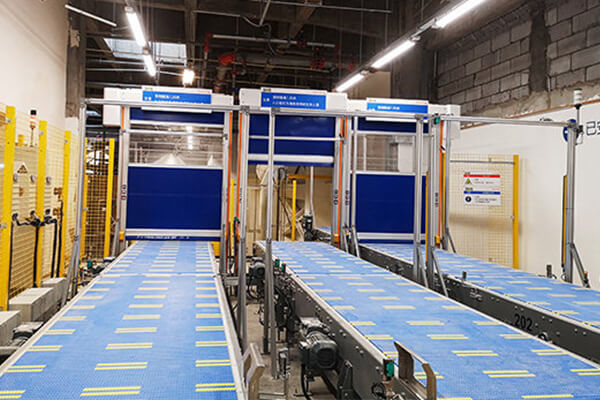With the development of logistics and warehouse management, many companies have adopted semi-automated operations in their workshops and warehouses. Especially in large-scale warehouses and production facilities, high-speed doors not only improve opening and closing speeds but also help companies better manage internal logistics. By integrating with conveyor systems, high-speed pvc doors can automatically open and close quickly, enabling materials to flow smoothly and efficiently.
This article will delve into how high-speed pvc doors, particularly those integrated with conveyor belt systems in IKEA warehouses, can enhance warehouse efficiency, reduce labour costs, and improve operational safety. Through case studies, we will demonstrate how high-speed doors effectively improve working conditions, reduce energy consumption, and boost productivity in modern warehouse operations.

Contents
The Challenges in IKEA’s Warehouse Operations
Challenges Faced by Traditional Warehouses
Traditional warehouse door systems often suffer from inefficiency. For example, slow door opening speeds frequently cause blockages in logistics channels, thereby affecting overall production efficiency. In addition, many traditional doors have poor sealing properties, leading to air leakage and increased energy consumption. Inefficient door systems also result in poor material flow, increasing labour costs and reducing the overall operational efficiency of the warehouse.
Why Speed and Efficiency Matter
In modern warehousing facilities like IKEA, frequent opening and closing operations are the norm. High speed door system ensures rapid material movement. Not only accelerating logistics turnover but also avoiding energy loss caused by prolonged door openings. In an efficient logistics environment, the application of fast doors is critical. It optimizes workflows, reduces waiting times, and meets the demands of large-scale production. For any modern warehouse, especially those like IKEA that require efficiency and speed, selecting the appropriate rapid door system is crucial.
The Role of High-Speed Doors in IKEA’s Conveyor Belt Systems
Improving Logistics Efficiency and Speed
In IKEA’s warehouses, the combination of high-speed roll up doors and conveyor belt systems reduces downtime during the conveying process. By sending signals to control the rapid opening of the doors, automation allows goods to pass through without manual intervention. Whether it’s raw materials, semi-finished products, or finished goods, all materials can pass through quickly, significantly improving logistics efficiency and avoiding operational delays caused by traditional door systems.
| Feature | High-Speed Door | Traditional Door |
|---|---|---|
| Opening Speed | 0.8–1.5 m/s | 0.2–0.5 m/s |
| Opening/Closing Time | 3–5 seconds | 15–20 seconds |
| Frequency of Use | High (frequent openings) | Low (infrequent openings) |
| Efficiency Impact | Significant time savings | Frequent downtime |
| Energy Loss | Minimal, due to quick closing | High, due to slow operation |
Excellent Sealing and Protection
Rapid roller doors offer exceptional sealing performance. The brush seals on both sides of the door and the U-shaped bottom edge of the door curtain effectively block external dust and air pollution. This is crucial for preserving the quality and safety of items on the conveyor belt, especially in areas with strict cleanliness requirements (such as food or pharmaceutical storage zones). The excellent sealing ensures materials remain free from external contamination. Thereby elevating the quality standards of all products within the warehouse.
Improved Energy Efficiency
High-speed doors offer significant advantages in controlling airflow. By reducing air exchange when the door is open, they help IKEA warehouses maintain constant temperature and humidity levels, preventing the entry of external hot or cold air. This is not only critical for environmental temperature control but also effectively reduces energy consumption. The energy required to maintain a controlled environment is significantly reduced, resulting in substantial cost savings and aligning with IKEA’s strategic goals for sustainable development.

The IKEA Case: Why High-Speed Doors Are a Smart Choice for Any Automated Warehouse
The success at IKEA’s facility is not an isolated incident. While the scale of IKEA is immense, the underlying challenges of efficiency, control, and safety are universal. Here’s why our solutions are a smart choice for any automated warehouse, regardless of its size.
Scalability & Versatility
Whether you’re a burgeoning e-commerce business with a single conveyor line or a large-scale distribution center. Our high-speed door solutions are designed to scale with you. Our high-speed door motors feature multiple expandable ports.
Customization Options: Built for Your Specific Needs
We offer a comprehensive range of customization options to tailor each door to your precise requirements, ensuring it becomes a perfect fit for your facility.
- Material Selection: Choose from 304 stainless steel frames for food-grade, pharmaceutical, or cleanroom environments, or select robust anodized aluminum for general warehousing and logistics applications where durability is key.
- Custom Dimensions: From small openings for parcel conveyors to large passages for automated guided vehicles (AGVs) and pallet systems, every door is manufactured to the exact dimensions of your opening.
- Operational Modes: We can program specific operational modes. This includes integration with AGV navigation, synchronization with production line tempos, or creating interlocking “Airlock” systems with two doors for strict environmental control.
Whether it is to improve the speed of material flow in warehouses or to automatically open and close doors through smart sensing, high-speed PVC doors have become key equipment for helping companies improve their overall efficiency. Especially in environments that require frequent operations and efficient logistics, high-speed doors can significantly improve operational processes, enhance work safety, and help companies save energy costs.




